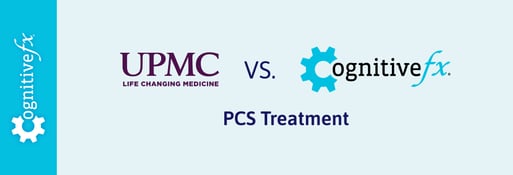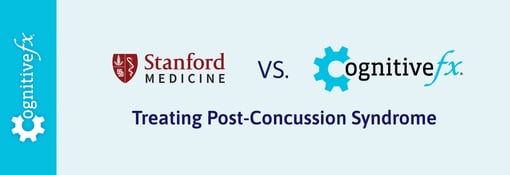Founded about 30 years ago by Dr. Deborah Zelinsky, the Illinois-based Mind-Eye Institute (formerly known as Mind-Eye Connection) specializes in treating patients with visual processing disorders related to traumatic brain injuries (TBIs), such as stroke and concussion, learning disorders such as ADHD, and autism spectrum disorder, among other conditions.
In simple terms, visual processing refers to our brain’s ability to receive and process visual signals, allowing us to react and respond to our surroundings. Any condition that disrupts this mechanism can cause visual symptoms, such as blurred vision or problems focusing. To treat these patients, the team at Mind-Eye Institute uses therapeutic eyeglasses with a mix of filters and prisms to improve the quality of visual input to the brain, which can help it function better.
This approach can be helpful for patients who are experiencing mainly visual issues after a concussion or TBI. However, for many TBI patients, addressing vision problems in isolation is not enough to resolve the persistent symptoms they experience, such as headaches, brain fog, dizziness, and cognitive issues. Often, these patients need to address other issues, such as cervical neck instability, vestibular problems, and cognitive problems, in addition to treating their vision. And importantly, each of these therapies needs to be carried out in concert with one another, because making too much progress in one area can disrupt success in another area.
At Cognitive FX, patients receive a combination of guided exercise and multidisciplinary therapy to target the functional problems stemming from brain injury (functional changes in the brain, nervous system, eyes, and inner ears). We use a detailed brain scan (fNCI), along with other physical and cognitive evaluations, to tailor each therapy regimen to the specific brain injury sustained by each patient.
If you’ve been suffering from persistent, lingering symptoms after a concussion or TBI, getting treatment at Mind-Eye Institute or Cognitive FX could help resolve some of your symptoms. To help you decide which clinic might be best for you, we provide a detailed breakdown and comparison of our services in the following areas:
90% of our patients report reduced symptoms after their treatment at Cognitive FX. To see if you’re a good fit for our program, sign up for a consultation.
How Concussions and TBIs Affect Vision (and Why Vision Treatment Alone May Not Resolve Lingering Symptoms)

After a concussion, it’s common for patients to develop problems with their vision. More than two-thirds of patients experience some visual impairments, such as blurred vision and problems with focusing and eye movements. About half of these patients have more than one vision problem.
To understand why and how TBIs affect the visual system, it is helpful to understand how the brain and the eyes collaborate normally. Imagine looking at your mobile phone. Your brain directs your eye muscles to focus your gaze on a specific point. This image is then transmitted via the optic nerve to the brain's occipital lobe, which is primarily responsible for processing visual information. However, visual processing doesn't end there. The parietal lobe gauges the phone's distance from you, and the temporal lobe uses your memories to recognize what you’re seeing on your phone. A concussion can disrupt this intricate system by damaging any of these brain areas, leading to vision problems. Essentially, the brain's ability to control eye movements, interpret distances and recognize objects can be compromised.
With that said, vision is more than just seeing things. Your eyes (vision system) are in constant communication with your ears (vestibular system) and body (proprioceptive system). For these three systems to work in harmony, inputs reaching the brain need to match. For example, when you’re moving around in a room, your peripheral vision sends information to the brain about where you are in the room and where objects are relative to you. The vestibular system (located in your inner ears) and the proprioceptive system (formed by sensors in the skin, bones, and muscles) need to send matching information to keep your body in a stable upright position when moving and to prevent you from bumping into anything or feeling dizzy.
If a head trauma affects any one of these systems, patients can become confused about their surroundings and experience symptoms like dizziness, poor balance, and blurred vision. In addition, if the eyes, ears, and proprioception are not in sync, the brain needs to work overtime to understand what information to follow, causing headaches, fatigue, and brain fog.
Vision treatments — like the ones offered at Mind-Eye Institute — can be an important aspect of treating patients with concussion and TBI symptoms. However, as we can see, the visual system’s complexity and its integration with multiple brain systems mean that head trauma often results in a broad spectrum of physical, cognitive, and emotional symptoms. To effectively address them, many patients need a coordinated effort that combines various therapeutic approaches simultaneously.
With that in mind, we can now discuss key similarities and differences between concussion and TBI treatment at Mind-Eye Institute and Cognitive FX.
Mind-Eye vs. Cognitive FX: Staff Expertise

Mind-Eye Institute
Mind-Eye specializes in treating vision-related symptoms caused by multiple conditions, including brain injuries, concussions, stroke, and other neurological disorders, as well as underdeveloped visual processing skills in children and adults who struggle with learning deficits, such as ADHD and autism.
As such, their team is mostly comprised of eye care professionals, including opticians, optometrists, and vision rehabilitation specialists. These healthcare professionals use state-of-the-art optometry techniques to provide relief to patients who are experiencing symptoms such as strabismus (misaligned or “crossed” eyes), amblyopia (“lazy” eye), accommodative and convergence disorders, and vision-related learning disorders. They also have a team of new patient advocates and patient advocates to answer questions and guide patients and loved ones during their treatment.
Cognitive FX
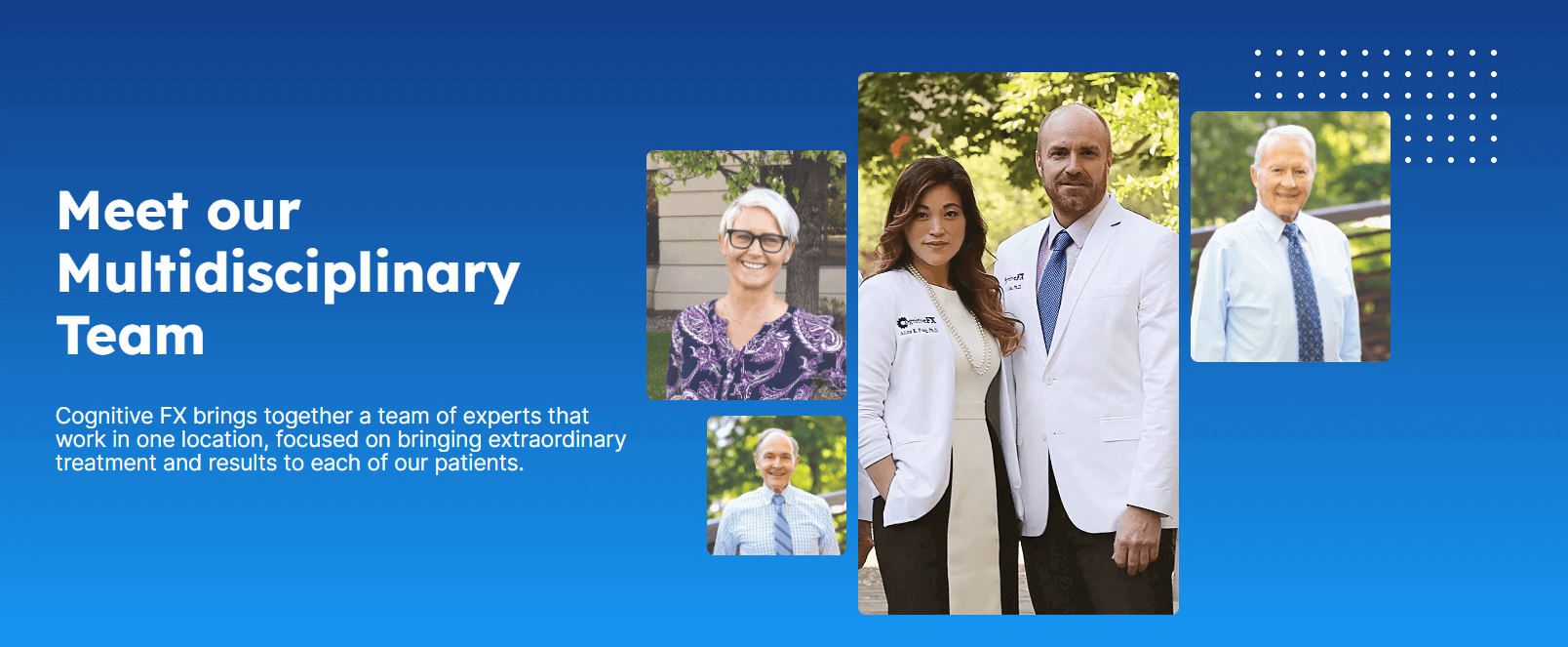
Our clinic, Cognitive FX, specializes in treating TBI patients with lingering cognitive, physical, and emotional symptoms that have persisted for months or years after injury. To treat them, we have a diverse team of medical specialists, including:
|
|
|
|
|
- Speech-language pathologists
|
- Clinical neuropsychologists
|
|
|
|
- Vision and vestibular specialists
|
|
|
|
|
|
- Licensed massage therapists
|
Our team’s expertise is centered around treating the root causes of post-concussion syndrome and TBI symptoms. Specifically, we provide targeted therapy for addressing neurovascular coupling dysfunction — one of the main causes of lingering symptoms after brain injury.
Under normal conditions, brain cells communicate with surrounding blood vessels to ensure a timely and precise delivery of oxygen and nutrients, a process known as neurovascular coupling (NVC). Concussions and other TBIs can disrupt this vital connection, leading to some brain areas receiving inadequate or excessive nutrients, or receiving them at inappropriate times. As a result, these areas struggle to perform their tasks, and other areas of the brain have to compensate. This compensation places considerable strain on the brain, depleting its energy and function, which can manifest in a range of symptoms, such as brain fog and headaches.
Our team is also trained to identify problems caused by dysfunction of the autonomic nervous system (ANS). The ANS includes the sympathetic nervous system (SNS) and the parasympathetic nervous system (PNS). In simple terms, the SNS controls the “fight or flight” response to stressful situations, while the PNS is responsible for the calmer “rest and digest” process. These two systems work together in harmony, but brain injuries often disrupt this balance. In most patients, the SNS stays active most of the time (even when the stressful situation is finished), causing symptoms such as fatigue, irregular breathing, high or low blood pressure, neck pain, headaches, digestive issues, dizziness, sensitivity to light, and more.
Further reading: Post-concussion ANS dysfunction (dysautonomia)
In addition, we have a variety of therapists who specialize in treating specific PCS symptoms, including vision, vestibular, and cognitive problems. Our therapists use many different exercises tailored to each patient to address their symptoms. Patients can receive one type of therapy in isolation, but often, our therapists combine exercises from multiple therapies to address different symptoms at the same time.
Overall Comparison
Given that the Mind-Eye Institute focuses exclusively on treating visual processing problems, their team is mostly composed of eye doctors and vision specialists, including opticians, optometrists, and visual rehabilitation therapists.
In contrast, the team at Cognitive FX includes a wide range of medical specialists, including neuroscience specialists, neurologists, psychologists, and a variety of therapists, to name just a few.
Mind-Eye vs. Cognitive FX: Patient Evaluation
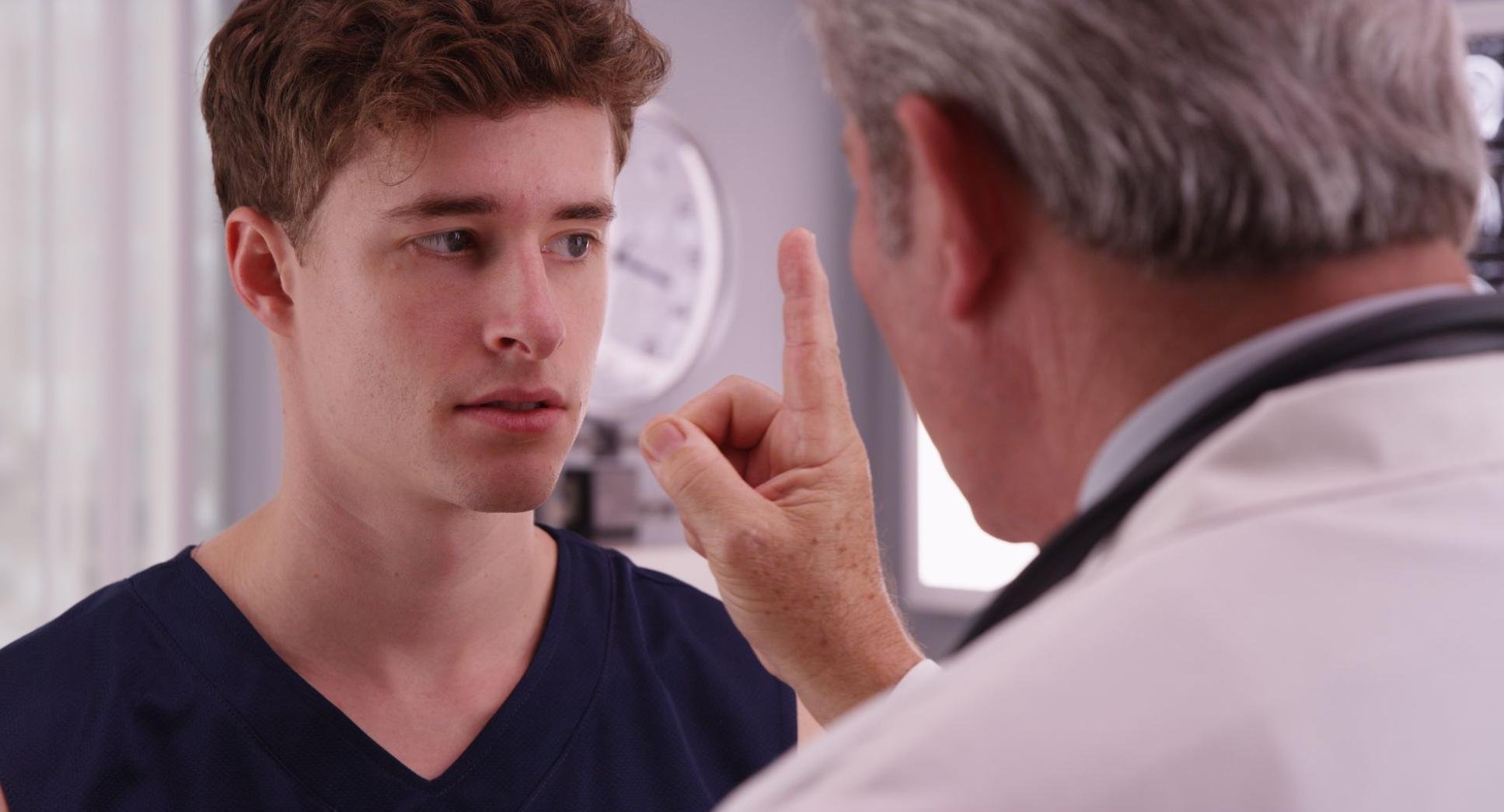
Mind-Eye Institute
Mind-Eye Institute uses several techniques to examine visual performance and processing skills. Patients go through a detailed evaluation process to detect even subtle visual and auditory issues.
The main test conducted during the evaluation is called the Z-Bell test, which was developed by Mind-Eye’s founder, Dr. Deborah Zelinsky. The test measures how changes in the light that hits the retina affect how the brain interprets and reacts to information about the environment. These effects can be explained as either image-forming or non-image-forming visual processes. Image-forming vision allows the brain to identify objects in the environment and distinguish their physical characteristics, such as size, shape, and movement. In contrast, non-image-forming processes affect the body in other ways, including regulating heart rate and body temperature, as well as changes in higher functions, such as mood and cognitive performance.
In practical terms, patients sit in a chair with their eyes closed during the test. The therapist rings a pitched bell on each side of the patient and asks the patient to reach out and touch the bell (still with eyes closed). The patient is then fitted with various prescription glasses (including some with tinted lenses or partially occluded lenses), and the therapist repeats the bell ringing. In addition, therapists can also change lighting conditions and use different bells.
At the end of the eye exam, if the prescription glasses can correct non-image-forming retinal processing problems, the patient’s ability to reach the bell improves. The key to this test is that closed eyelids filter out the light used for eyesight image processing but let in enough light to trigger retinal responses in non-image-forming processing, which operates at very low light levels.
Mind-Eye optometrists also use a variety of other tests and learning games to evaluate overall visual performance, visual function, and visual processing capabilities, including eye alignment; eye movements and tracking; eye-hand coordination; binocular vision and depth; visual-motor and perceptual-cognitive skills; and various visual systems’ integration with other sensory systems, including hearing and balance.
Once all the tests are completed, Mind-Eye therapists design an individualized treatment plan, typically using Mind-Eye glasses to modify external eyesight. Patients are also given exercises to complete at home to improve their vision.
Cognitive FX
At Cognitive FX, we also perform a thorough vision assessment as part of our evaluation process. Our visual exam includes:
- Saccades: Testing the patient's ability to accurately move the eyes from one designated focal point to another in a single, quick movement.
- Convergence/Divergence: Testing how a patient’s eyes rotate inward (converge) and outward (diverge) as an object moves closer or farther away, helping to assess depth perception.
- Peripheral vision: Testing the patient’s awareness and ability to see the edges of their visual field without moving their head.
- Visual processing: Testing the patient’s ability to “See, Process, and Respond” in different situations. For example, following a coordination chart where one prompt is a cue for the right hand, another for the left, and another for both. We assess how accurately and quickly a patient can complete this task. (In daily life, this would relate to seeing a traffic light turn yellow and then red. Do you see the light change and react appropriately and in time?)
- Right Eye exam: Eye-tracking software that assesses subtleties of how a patient’s eyes are moving, which eye muscles are working properly, and which aren’t.
Importantly, we assess each of these skills from a functional and a neurological perspective. In addition to looking at the specific function itself, and how well the patient is performing it, we also look at the nerves and brain regions responsible for these tasks. This allows us to rehabilitate the skills more quickly and fully.
However, vision is just one of several physical and cognitive systems that we assess before developing a treatment protocol. Our evaluation also includes:
- A meeting with one of our doctors to review the patient’s medical history and symptoms.
- A physical exam to check balance, hand-eye coordination, reaction times, and other physical abilities.
- A neurocognitive test to assess memory, concentration, reasoning, and other cognitive functions.
- A psychological evaluation to identify symptoms of anxiety, depression, and other mental health problems.
- A structural brain and cervical spine MRI to spot any serious structural injuries that need medical treatment before patients start with us.
- A brain imaging scan called functional Neurocognitive Imaging (fNCI) to determine where and how the patient’s brain was affected by the concussion.
The fNCI scan measures blood flow in 100 different regions of the brain while patients carry out a set of standardized cognitive tasks. It produces a series of real-time images that are combined and compared with scans from healthy people to identify the areas where NVC dysfunction is affecting normal brain function.
Regions are grouped according to function and then scored. Green scores show normal function, while yellow and red scores identify sections with neurovascular coupling dysfunction.
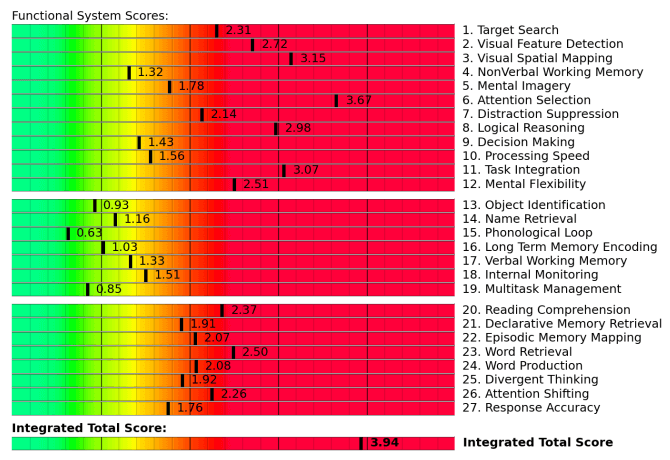
The scan also measures how these regions communicate with each other. Again, regions in green show normal activity, while regions in varying shades of blue are less active than normal.
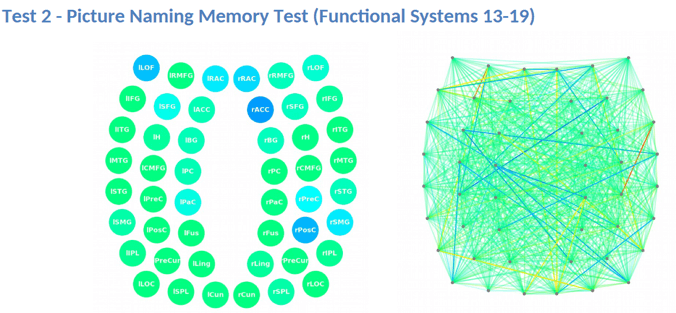
This information provides our staff with huge advantages when it comes to treating patients. For example, if we see visual systems such as target search, visual feature detection, or visual-spatial mapping aren’t working as they should, we can tailor exercises to work on those specific areas of the brain during therapy.
Sometimes, if we just assess vision on functional tasks, we may see that the patient performs very well. However, we often find on our fNCI that the brain regions and functional systems in charge of particular tasks are working very hard to do them, leading to fatigue and an increase in symptoms. If we didn't have the lens of the fNCI we would assess that skill as "normal" when in fact a visual skill that we do repetitively all day long is coming at a large energy cost.
Finally, the fNCI allows us to see how visual systems are performing in context with the other key functional systems of the brain, enabling us to coordinate different types of therapies together.
After patients complete this evaluation, our team combines all the information and designs a customized treatment plan to target exactly the areas of the brain that show dysfunction for each patient.
Overall Comparison
Patient evaluation at the Mind-Eye Institute relies heavily on the results from the Z-bell test, which assesses non-image-forming processing in the brain. Although this may give their team an idea about how the head injury affected the patient’s neural pathways — especially those linked to the visual system — it still cannot pinpoint exactly what areas were affected and how.
At Cognitive FX, patients are assessed in a wider range of areas (physical, cognitive, emotional) and undergo a brain imaging scan to reveal how blood flow circulates in 100 brain regions. This is an indication of how each brain region is working (or struggling) and can be used to design a custom-made treatment plan for each patient.
Mind-Eye vs. Cognitive FX: Treatment
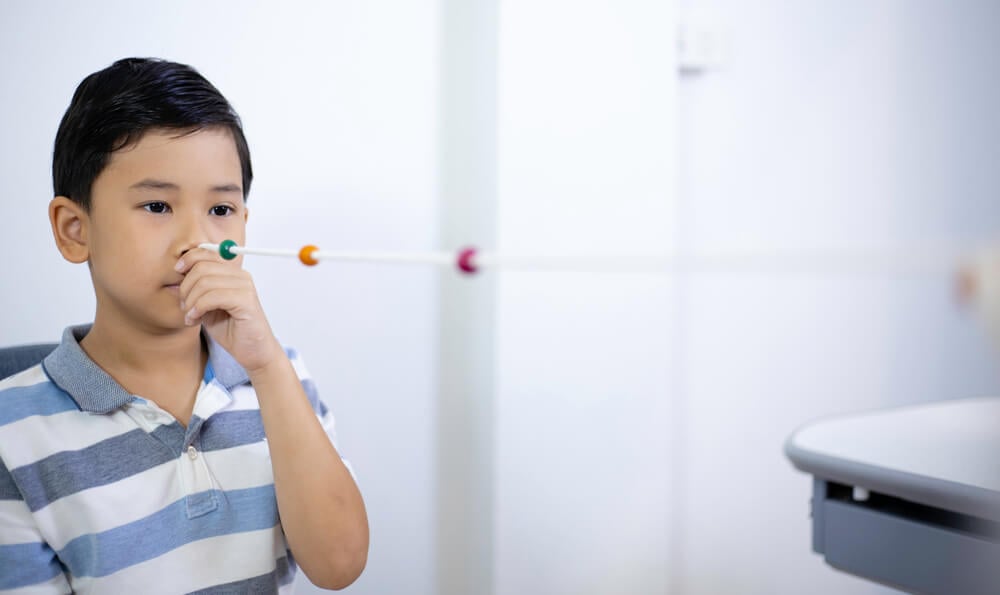
Mind-Eye Institute
The main form of treatment offered by Mind-Eye Institute is a type of glasses that they call “brain glasses” or “Mind-Eye brainwear” because of their therapeutic properties. According to the team at Mind-Eye, the glasses rely on a mix of lenses, filters, and prisms to improve how the brain processes visual information and coordinates it with input from the vestibular system. You can think of the glasses as a way to provide a better environment for the eyes and brain to communicate and work together.
In practical terms, the lenses, filters, and prisms in the glasses alter how the light disperses across the retina. The theory is that light stimulation can rebuild (or, at least, bypass) damaged brain pathways and improve patients’ spatial awareness, body posture, perception, and selective attention to sound.
For example, if the glasses adjust the light to go sideways onto the retina, patients are “forced” to rotate their head and neck into a straighter position. This can help with some concussion symptoms, such as headaches, light and sound sensitivity, balance, sleep problems, and issues with memory, concentration, focus, organization, and decision-making.
Patients need to go through a series of glasses during their treatment, which may take between 2 to 3 years to complete until they don’t need glasses anymore. During this time, patients attend a few follow-up appointments every year to check up on progress and possibly change prescription lenses.
Cognitive FX
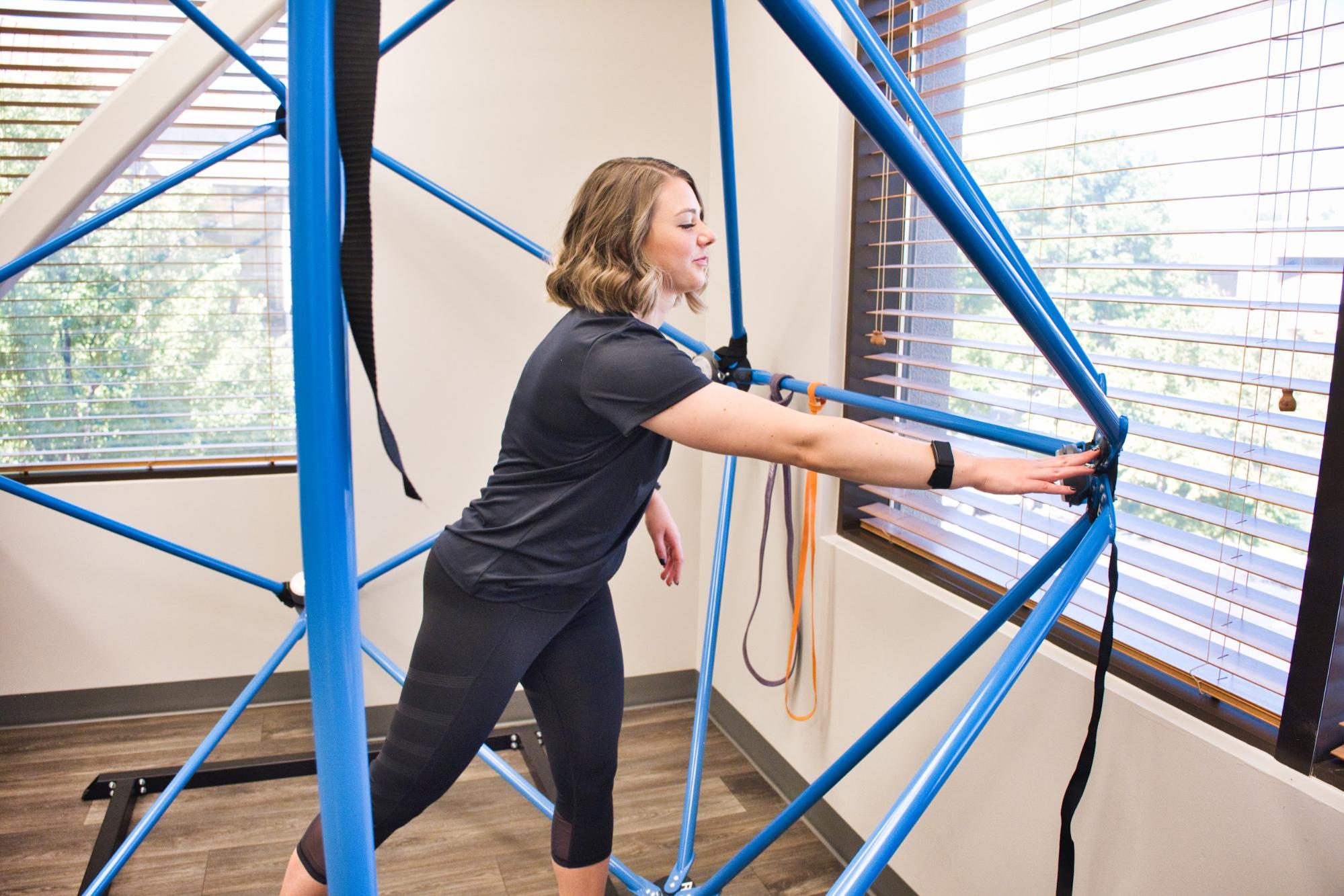
Instead of relying only on glasses to treat visual symptoms in isolation, our treatment — called Enhanced Performance in Cognition (EPIC) — is a custom, week-long program designed to treat each patient’s specific symptoms, including vision problems.
During treatment week, patients go through an intense regime of aerobic exercise and a variety of different therapeutic interventions. Patients will receive most of the therapies listed below, but the exact combination of exercises within each therapy varies considerably, depending on the results of the brain scan.
Cognitive
therapy |
- The aim is to engage key brain regions and rehabilitate cognitive skills, such as memory, attention, decision-making, and reasoning.
- Patients engage in cognitive activities, such as solving logic puzzles and identifying word patterns.
|
| Occupational therapy |
- Patients engage in exercises that help the brain, body, and eyes coordinate with each other.
- Therapists help patients readjust to their daily activities by focusing on difficulties identified on their fNCI scan, including compensatory strategies for work and school as they recover.
|
| Neuromuscular therapy |
- The aim is to relieve headaches and neck pain, rehabilitate balance, improve body-brain coordination, and promote physical activity.
- Patients receive massages, stretches, and soft tissue manipulation to increase blood flow.
- Patients engage in cognitive games and physical therapy exercises.
|
| Sensorimotor therapy |
- The aim is to improve cognitive and physical skills and reduce symptoms of depression.
- Patients follow simple movement patterns in time with a metronome to address cognitive, visual, and vestibular symptoms.
|
| Visual skill and processing therapy |
- The aim is to address vision problems, such as blurred vision, difficulty focusing, and light sensitivity.
- Patients engage in different exercises, including Dynavision, visual tracking exercises, the Brock String, and some other computerized technologies.
- If patients need further therapy after treatment, our therapists can help find a suitable neuro-optometric rehabilitation program.
|
| Neuro integration therapy |
- The aim is to assess the visual, vestibular, and proprioceptive systems and their functions, and integrate them to improve patients’ ability to function in the world.
- Patients receive help with a variety of vestibular issues, including poor posture, dizziness, and vertigo. Vision exercises are often incorporated as well, such as saccades, near/far focusing, convergence/divergence, peripheral awareness, and hand/foot/eye coordination.
- Patients engage in gaze stabilization and balance exercises. For example, patients catch a ball while standing on a balance board or walk in a figure eight pattern while keeping their eyes focused on a point.
|
| Psychotherapy |
- Patients meet with a clinical psychologist to evaluate their mental health status.
- For patients suffering from depression and anxiety, our therapists recommend cognitive behavioral therapy (CBT). We do not offer this type of therapy but can refer them to a specialist.
- Patients learn mindfulness exercises and other relaxation strategies to improve their quality of life.
|
Almost all of our therapies include a visual component, though some focus on vision more heavily than others. Some examples include Dynavision and the Brock string.
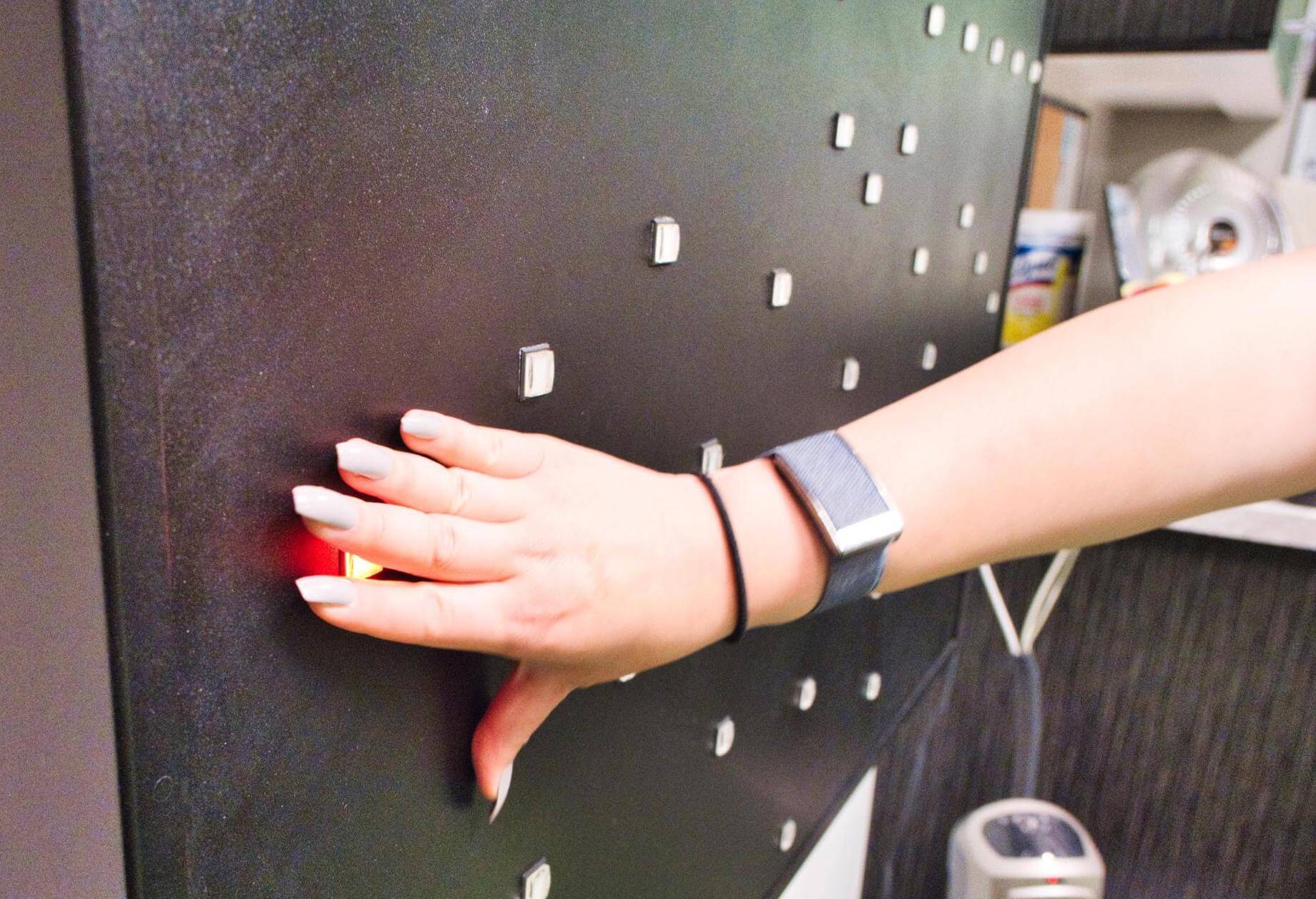
Dynavision is a computerized light board where patients push buttons as they light up in different patterns on the board. Sometimes, you’ll simply hit every button that lights up as quickly as you can after noticing it. Other times, you’ll need to exercise selective button-slamming skills by hitting only the red while avoiding the green, for example. Dynavision is great for oculomotor coordination and for activating several brain regions involved in movement, cognition, and vision.
We also use the Brock string for patients with visual perception issues. This tool helps retrain the eyes to work together when you focus on beads located at different distances along the string.
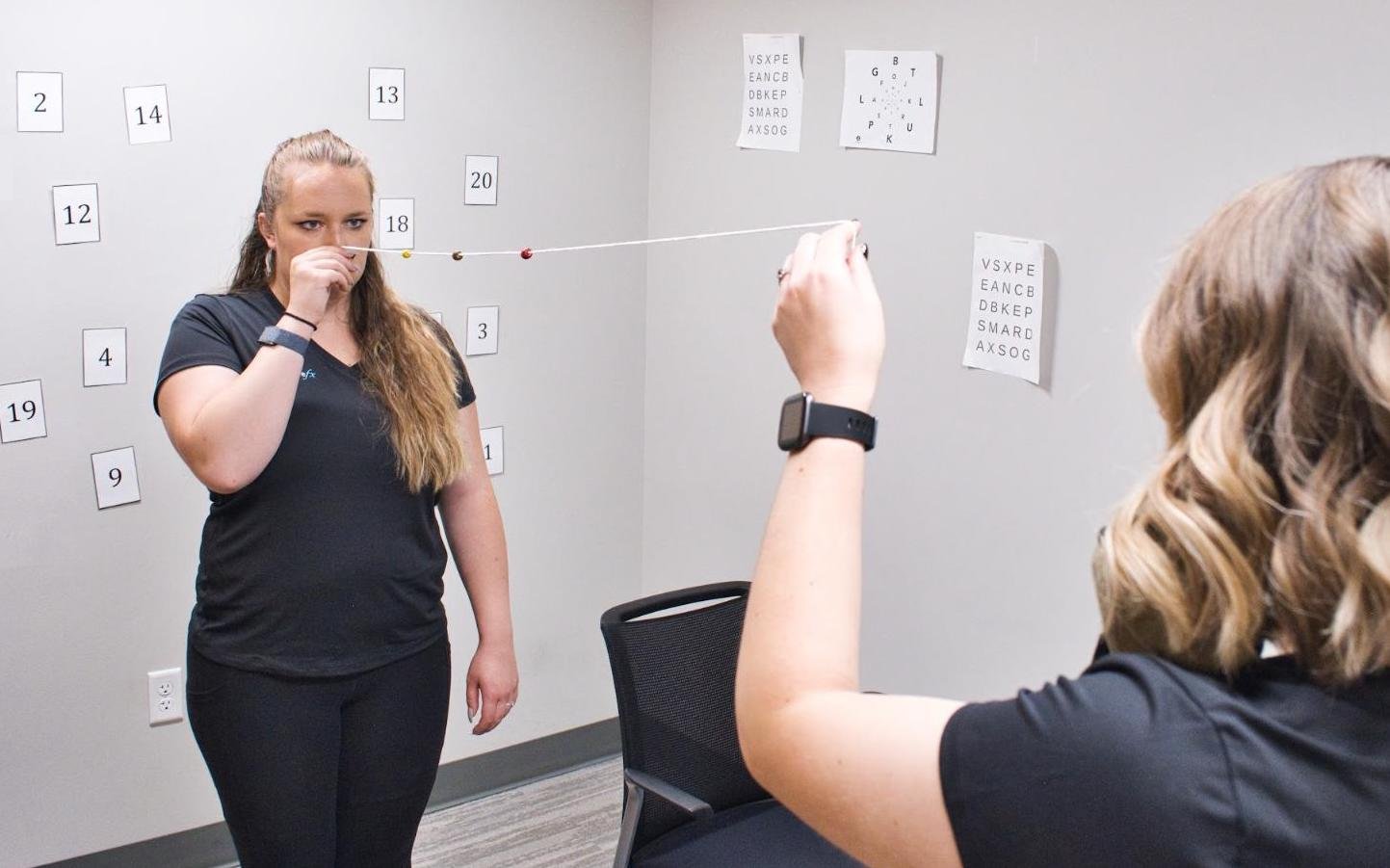
In neurointegration therapy, you’ll perform exercises designed to help the brain, eyes, inner ear, and body to work together harmoniously.
The overall effect of these therapies working in combination is greater than if you were just pursuing one type of therapy at a time. When you activate the whole brain, positive changes tend to happen faster and in larger bursts because of the way the treatment works as a whole. Sometimes, we’ll see patients who had been receiving vision therapy but who hit a plateau in treatment. When they come to Cognitive FX and have the neurovascular coupling component addressed, it’s much easier for their system to respond to vision therapy and resume improving.
That said, the eyes are slow to change. One week’s worth of therapy is often not enough to address all vision issues. The eyes can take anywhere from six months to a year of vision therapy to recover fully. Treatment at Cognitive FX can provide a significant reduction in symptom burden and resolve many of the underlying issues, but there is no replacement for consistency in vision rehabilitation. We can refer you to a vision specialist in your hometown and teach you specific exercises to do at home.
A second follow-up fNCI at the end of the treatment allows our team to see how brain function is improving. 90% of our patients experience improvements during treatment, and most continue improving at home.
After your follow-up scan, a member of our team will analyze your results and give you some “homework.” Your homework will include some combination of aerobic exercise, cognitive games, and cognitive rest as you continue your recovery journey.
Overall Comparison
The Mind-Eye Institute treats patients with traumatic brain injuries using a series of brain glasses that gradually improve visual processing. In theory, their treatment targets both image-forming and non-image-forming visual processes in the brain. It aims to treat not only visual symptoms — such as eye tracking, hand-eye coordination, and depth perception — but also to promote integration between visual and other sensory systems, including hearing and balance.
In contrast, Cognitive FX uses a tailored combination of aerobic exercise and multidisciplinary therapies to address root causes and treat a wider array of symptoms that TBI patients commonly deal with, including vision, vestibular, proprioceptive, cognitive, and emotional issues. Often, our patients will engage in exercises that target more than one problem at the same time. For example, our therapists may ask patients to balance on a Bosu ball (balance training) and recite the names of animals alphabetically (cognitive therapy) while catching a ball (vision/physical therapy).
Importantly, our team is constantly communicating with each other about our patients’ progress and how to adjust the type of therapy they receive. Our doctors and therapists use a Teams channel to discuss therapeutic approaches between appointments. We often find Dr. Allen or Dr. Fong greeting patients in the hallway and commenting on the therapy they just came from!
We find that over 90% of Cognitive FX patients experience improvements in symptoms by the end of their first week of treatment, and the average symptom improvement is over 60%. These results are only possible thanks to an incredible level of coordination and communication between staff.
Pricing and Insurance

Mind-Eye Institute Cost
The cost of the treatment varies depending on the patient’s situation. Mind-Eye does not bill insurance companies directly but can provide the CPT procedure codes and superbills for patients to submit to their insurance for partial reimbursement for out-of-network benefits.
In addition, they also have options for financial aid, and patients can apply via their financial aid forms. This puts services on a sliding scale based on income.
Cognitive FX Cost
Cognitive FX is not an in-network provider with any insurance providers. Like Mind-Eye, we can provide CPT codes (see the full list on our pricing page), and some of our patients may obtain partial reimbursement when filing with their insurance companies.
Our treatment is costly, but we believe it’s priced fairly for the treatments we offer. No other clinic in the world can boast a medical team as extensive as ours, nor do they offer the same level of personalized treatment, thanks to the fNCI results.
We have four packages for patients to choose from, ranging from $2,500 to $24,700. If you pick one of the packages with just the brain scan — “fNCI only” or the “fNCI + Action plan” — but later decide to continue treatment with us, the initial cost is credited to the cost of treatment. For example, if you choose the fNCI scan only but then decide to attend one week of treatment, your treatment plan cost would be $10,500 ($13,000 less the $2,500 you already paid for the scan).
If you need help choosing the right treatment plan, a member of our team would be happy to discuss options with you.
.jpg?width=1472&height=1999&name=Comparing%20Treatment%20Plans%20at%20Cognitive%20FX%20(2024).jpg)
Conclusion
Staff
Most of the Mind-Eye team includes vision-related healthcare professionals, such as opticians, optometrists, and visual rehabilitation therapists.
In contrast, our team at Cognitive FX is more diverse and includes a wide range of medical specialists, such as neurologists, psychologists, and different types of therapists.
Evaluation
Patient assessment at the Mind-Eye Institute relies heavily on the Z-Bell test developed by the founder Dr Zelinsky. This shows how the brain injury affected the patients’ visual processing, but it cannot identify the areas in the brain that may be causing other symptoms — such as emotional and cognitive problems — that may also need treatment.
Cognitive FX offers a more in-depth evaluation with a functional brain scan to identify all of the areas affected by the injury. These results are key to designing a customized treatment for each patient.
Treatment
Treatment at Mind-Eye Institute involves getting a series of prescription glasses and exercises to complete at home.
At Cognitive FX, patients are guided through a week-long treatment program, facilitated by a multidisciplinary team that works together to ensure all aspects of treatment are performed in concert with one another.
On average, our patients’ symptoms improve by 60% after just one week of treatment. To see if you are eligible for treatment, sign up for a consultation.


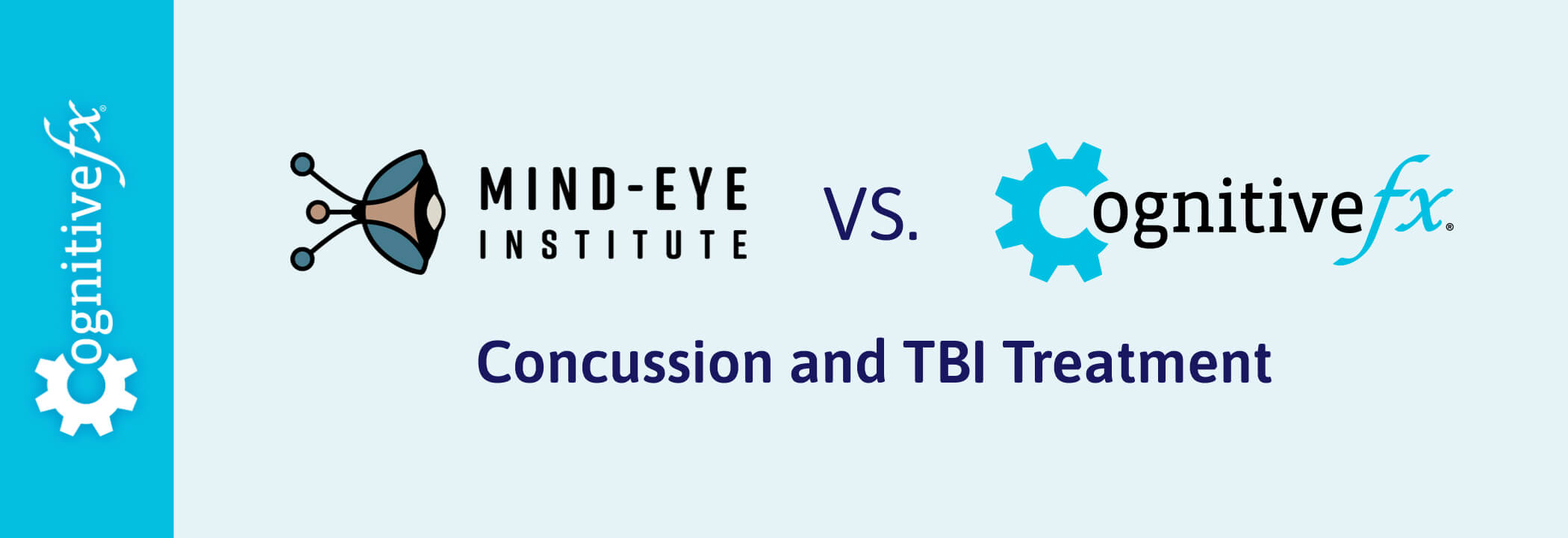










.jpg?width=1472&height=1999&name=Comparing%20Treatment%20Plans%20at%20Cognitive%20FX%20(2024).jpg)

